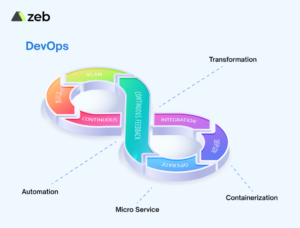According to Google Cloud’s study, the most important determinant of success for rapid deployment is application modernization that accommodates an unrestricted microservices design. Top organizations such as Netflix, Tesla, and Starbucks have already demonstrated this through their success.
Nevertheless, application modernization has been a laborious process that includes multi-year initiatives with a substantial failure probability.
Using proof-of-concept DevOps practice is the only ideal solution to unlock, enhance, and expedite your firm’s application modernization efforts.
In other words, DevOps is an unbeatable way to modernize modernization.
1. The Fundamental Composition of Modernization
2. The Process of Incorporating DevOps in App Modernization
3. The Advantages of ‘Modernizing’ App Modernization through DevOps
The Fundamental Composition of Modernization
Application modernization is comprised of transformation, integration, automation, and optimization. All four elements necessitate adaptability and cultural alterations. That’s why DevOps needs to be implemented. It unleashes CI/CD procedures by uniting all four compositions. Furthermore, it streamlines the development pipeline and deployment by emphasizing more on delivery and testing.

In Transformation
- DevOps enables quick, substantial, and reliable software development in cloud-native app development.
- Firms can gain from faster deployment of improvements when development and operations teams are unified.
- Benchmarks in DevOps give developers a low-risk technique of undoing modifications, making room for creativity.
- Recovery from incidents in the event of a cluster breakdown is also quicker with the capacity to accurately overturn.
In Integration
- DevOps verifies that development and operations teams communicate well.
- Using compact data collectors, it is easier to detect code flaws immediately.
- It streamlines application mechanisms.
- Numerous development pathways can be supported with DevOps.
- Lastly, it helps proactively track crucial variables.
In Optimization
- DevOps guarantees that the software development layout can survive any event such as making minor updates to the system.
- DevOps enables a business to better optimize its assets in order to build strong software more rapidly and at a lower expense.
- Development phases are efficient and more flexible, establishing a forward-thinking and creative landscape.
- Disruption timeframe is mitigated, and deployment hazards are curtailed, thereby minimizing vulnerabilities.
In Automation
- One of the primary goals of DevOps is automation coupled with a short feedback process.
- The bulk of issues is rectified in time as a result of immediate and constant reporting, allowing for rapid launches.
- Being built on automation, the DevOps approach provides deliveries in a short period of time and helps deploy consistently across platforms.
- Consequently, automation promotes velocity, increased precision, continuity, and dependability, as well as a spike in the proportion of deliveries.
The Process of Incorporating DevOps in App Modernization
DevOps offers a comprehensive strategy for administering and enhancing business technology in order to accomplish effective IT modernization. The methodology is systematic and significantly improves the outputs of the app modernization journey.
It mainly comprises four elements
Initiative – Launching the DevOps venture with an evaluation of the ecosystem
Strategy – Constructing a DevOps approach personalized to your infrastructure
Toolbelt Lineup – Determining the best resources for the DevOps transition
AWS ECS – Allocating your application to different microservices with appropriate components
Through this approach, DevOps has a significant influence on your application modernization mission and facilitates the following
Continuous Integration – Artefacts can be constantly created and authenticated.
Continuous Deployments – Artefacts can be delivered between systems without difficulty.
Infrastructure Automation – Using GitOps techniques, merge infrastructure automation with CI/CD.
Automated Testing – Automated monitoring to achieve DevOps-oriented rapidity and flexibility.
Observability – Detecting trends in order to undertake sequential system troubleshooting.
The Advantages of Utilizing DevOps in Application Modernization
Greater periodicity of deployment – Launch new additions every one to six months or dozens of times each day.
Reduced update duration – Enable modifications to be made in less than a day, from code submission to code properly functioning in operation.
Decreased time for reinstating operations – Trace causative factors and apply solutions at a much quicker speed since cross-functional groups can collaborate. Consequently, failure rates are lowered.
Lowered failure rates – Error rates are drastically reduced from 60% to 0-15%.
Increased adaptability – Improved adaptability among infrastructure providers if more challenging choices emerge.
Harness the Power of Our DevOps Solutions before Embarking on App Modernization
We view DevOps as more of an intellectual revolution in regard to application development and application modernization. That’s why our approach towards building a tailored DevOps framework for your enterprise is unparallel.
Reap the benefits of effective re-engineering and restructuring by placing our DevOps methodology at the heart of your app modernization journey.